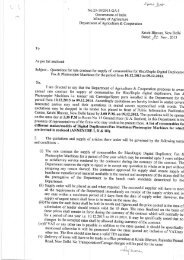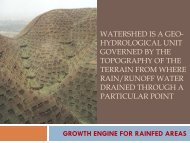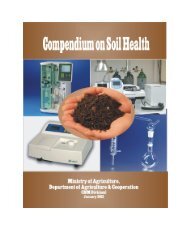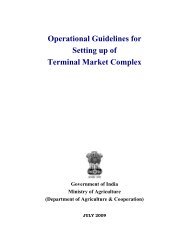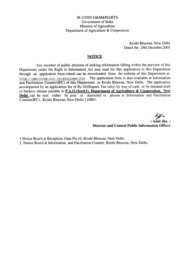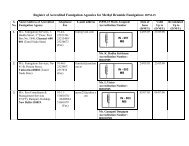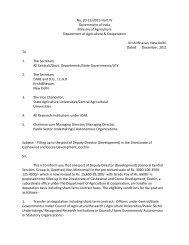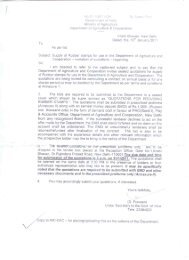Future Requirements of Agricultural Machines for Mechanizing ...
Future Requirements of Agricultural Machines for Mechanizing ...
Future Requirements of Agricultural Machines for Mechanizing ...
Create successful ePaper yourself
Turn your PDF publications into a flip-book with our unique Google optimized e-Paper software.
1. Manufacturers should ensure that every part <strong>of</strong><br />
dangerous machines confirms to BIS standards.<br />
2. Duty <strong>of</strong> manufacturers to supply operators<br />
manuals with each dangerous machines.<br />
3. User to get dangerous machine registered.<br />
4. User to get the existing dangerous machine<br />
modified.<br />
5. Employers liability <strong>for</strong> compensation.<br />
6. Notice <strong>of</strong> accident.<br />
7. Open insurance policy <strong>of</strong> the operator.<br />
8. The bill authorities inspection and seizure <strong>of</strong> the<br />
machine causing death or injury.<br />
2.2.7 Safety Feeding Chutes: As a result <strong>of</strong> the<br />
Dangerous Machine Act the scientists designated safe<br />
feeding chutes <strong>for</strong> different type <strong>of</strong> threshers keeping in<br />
mind the anthropometric dimensions <strong>of</strong> the upper limbs<br />
so that they could not be pulled in to the thresher while<br />
feeding the crop in the thresher. Table 18 given gives<br />
the dimensions <strong>of</strong> safe feeding chutes to be fitted with<br />
the threshers to prevent accidents.<br />
2.2.8 Indian Standards Related to Safety: The<br />
following standards on safety have been <strong>for</strong>mulated by<br />
the Bureau <strong>of</strong> Indian standards:<br />
1. IS:12239(PT1):1996 Guide <strong>for</strong> safety and com<strong>for</strong>t<br />
<strong>of</strong> operator <strong>of</strong> agricultural tractors and power<br />
tillers: part 1 General requirements (first revision)<br />
2. IS:12239(PT2): 1988 Guide <strong>for</strong> safety and<br />
com<strong>for</strong>t <strong>of</strong> operator <strong>of</strong> agricultural tractors and<br />
power tillers: Part 2 <strong>Requirements</strong> relating to<br />
agricultural tractors<br />
3. IS:12239(PT3):1988 Guide <strong>for</strong> safety and com<strong>for</strong>t<br />
<strong>of</strong> operator <strong>of</strong> agricultural tractors and power<br />
tillers: Part 3 <strong>Requirements</strong> relating to Power<br />
tillers<br />
4. IS:8265:1996:<strong>Agricultural</strong> tractors - Guards <strong>for</strong><br />
power take -<strong>of</strong>f (PTO) drive shafts (second<br />
revision)<br />
5. IS:4931-1995:<strong>Agricultural</strong> tractors - Rear<br />
mounted power take <strong>of</strong>f types 1,2 and 3 (third<br />
revision)<br />
6. IS:5994-1987 Test code <strong>of</strong> agricultural tractors<br />
(second revision)<br />
7. IS:6024:1983 Guards <strong>for</strong> harvesting machines<br />
(first version)<br />
8. IS:9019:1971 Code <strong>of</strong> practice <strong>for</strong> installation,<br />
operation and maintenance <strong>of</strong> thresher<br />
9. BIS:6283:1971Symbols <strong>for</strong> operator controls on<br />
agricultural tractors and farm machinery<br />
10. IS:9020-1971 Safety requirement <strong>for</strong> power<br />
threshers<br />
11. IS:9129:1979 Technical requirements <strong>for</strong> safe<br />
feeding system <strong>for</strong> power threshers<br />
12. IS:9581:1988 Safety and operational requirements<br />
◆ 190 ◆<br />
STATUS OF FARM MECHANIZATION IN INDIA<br />
<strong>for</strong> pedestrian- controlled cylinder(reel) power<br />
lawn mower<br />
13. IS:9632:1988 Code <strong>of</strong> practice <strong>for</strong> operation and<br />
preventive maintenance <strong>of</strong> crop protection<br />
equipment<br />
14. IS:1061:1983 Pictorial representation <strong>for</strong><br />
cautionary notices <strong>for</strong> power threshers<br />
3. EMERGING TRENDS<br />
<strong>Agricultural</strong> mechanization trends are linked with the<br />
trends in agriculture, agro-processing and rural living,<br />
globalization <strong>of</strong> world markets and market trends, WTO<br />
obligations, and State and Central Government policies<br />
and demands <strong>of</strong> political constituents. Agriculture is a<br />
state subject. Decisions at state or regional level selfsufficiency<br />
or policy to concentrate on exploiting agroecological<br />
advantages and meeting short falls through<br />
imports from other states <strong>of</strong> the Union ora <strong>for</strong>eign source<br />
are likely to affect the mechanization trends. As <strong>of</strong> now<br />
things are in the state <strong>of</strong> flux. Country is faced with<br />
contradictory situations each having its own<br />
requirements including mechanization. Modernization<br />
requires sophistication in mechanization which is<br />
possible at relatively large scales <strong>of</strong> operations entailing<br />
capital and management constraints. Globalization puts<br />
heavy demand on competitiveness, reduced unit cost <strong>of</strong><br />
production, indirectly demanding mechanization and to<br />
a certain extent automation. These will lead to<br />
tractorisation. Marginal and small farmers are<br />
increasingly becoming part time, absentee farmers,<br />
periurban farmers, wage earners on part or full time<br />
basis. Industry and service sectors, trade and commerce<br />
unable to reduce land based livelihood compel the rural<br />
people to remain on land based livelihood, <strong>for</strong>cing steady<br />
increase in number <strong>of</strong> land holdings but average land<br />
holdings going down making mechanization more<br />
challenging and difficult. Scaling down <strong>of</strong> farm<br />
machines reduces mechanical advantages. Instead <strong>of</strong><br />
owning farm machinery other than hand tools such<br />
marginal farms can meet their needs through custom<br />
servicing, if it is well developed.<br />
1. Country is faced with the basic livelihood issue<br />
<strong>of</strong> the rural masses. With per capita arable land<br />
availability dwindling and average land holding<br />
coming down to levels that it is too difficult <strong>for</strong><br />
the farm families to have minimum acceptable<br />
standards <strong>of</strong> food, shelter, clothing, health care,<br />
and education, the Central and State Governments<br />
are seized with the issue <strong>of</strong> ways to widen<br />
livelihood base <strong>of</strong> these people. Increasing<br />
productivity; crop diversification towards<br />
horticulture, livestock husbandry, fishery and<br />
<strong>for</strong>estry; post-harvest management <strong>for</strong>



